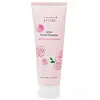What's inside
What's inside
 Key Ingredients
Key Ingredients

 Benefits
Benefits

 Concerns
Concerns

 Ingredients Side-by-side
Ingredients Side-by-side

Water
Skin ConditioningGlycerin
HumectantDipropylene Glycol
HumectantButylene Glycol
HumectantNiacinamide
SmoothingHydroxyacetophenone
AntioxidantArginine
MaskingCarbomer
Emulsion StabilisingPEG-60 Hydrogenated Castor Oil
EmulsifyingCaprylyl Glycol
EmollientXanthan Gum
EmulsifyingAmmonium Acryloyldimethyltaurate/Vp Copolymer
Betaine
HumectantDisodium EDTA
1,2-Hexanediol
Skin ConditioningSodium Hyaluronate
HumectantOryza Sativa Bran Extract
Skin ConditioningDipotassium Glycyrrhizate
HumectantParfum
MaskingWater, Glycerin, Dipropylene Glycol, Butylene Glycol, Niacinamide, Hydroxyacetophenone, Arginine, Carbomer, PEG-60 Hydrogenated Castor Oil, Caprylyl Glycol, Xanthan Gum, Ammonium Acryloyldimethyltaurate/Vp Copolymer, Betaine, Disodium EDTA, 1,2-Hexanediol, Sodium Hyaluronate, Oryza Sativa Bran Extract, Dipotassium Glycyrrhizate, Parfum
Water
Skin ConditioningStearic Acid
CleansingGlycerin
HumectantPotassium Hydroxide
BufferingPEG-90
HumectantCocamidopropyl Betaine
CleansingSorbitan Olivate
EmulsifyingPolyquaternium-7
Polysorbate 80
EmulsifyingPhenoxyethanol
PreservativeCaprylyl Glycol
EmollientAcrylates/C10-30 Alkyl Acrylate Crosspolymer
Emulsion StabilisingRose Extract
Skin ConditioningSodium Hyaluronate
HumectantDisodium EDTA
Hordeum Vulgare Leaf Extract
Skin ConditioningOenothera Biennis Flower Extract
AstringentCamellia Japonica Flower Extract
EmollientArnica Montana Flower Extract
MaskingCalendula Officinalis Flower Extract
MaskingLavandula Angustifolia Flower Extract
CleansingPaeonia Albiflora Flower Extract
TonicAnthemis Nobilis Flower Extract
Masking1,2-Hexanediol
Skin ConditioningPotassium Hyaluronate
Skin ConditioningHydrolyzed Sodium Hyaluronate
Skin ConditioningParfum
MaskingCitronellol
PerfumingGeraniol
PerfumingWater, Stearic Acid, Glycerin, Potassium Hydroxide, PEG-90, Cocamidopropyl Betaine, Sorbitan Olivate, Polyquaternium-7, Polysorbate 80, Phenoxyethanol, Caprylyl Glycol, Acrylates/C10-30 Alkyl Acrylate Crosspolymer, Rose Extract, Sodium Hyaluronate, Disodium EDTA, Hordeum Vulgare Leaf Extract, Oenothera Biennis Flower Extract, Camellia Japonica Flower Extract, Arnica Montana Flower Extract, Calendula Officinalis Flower Extract, Lavandula Angustifolia Flower Extract, Paeonia Albiflora Flower Extract, Anthemis Nobilis Flower Extract, 1,2-Hexanediol, Potassium Hyaluronate, Hydrolyzed Sodium Hyaluronate, Parfum, Citronellol, Geraniol
Ingredients Explained
These ingredients are found in both products.
Ingredients higher up in an ingredient list are typically present in a larger amount.
1,2-Hexanediol is a synthetic liquid and another multi-functional powerhouse.
It is a:
- Humectant, drawing moisture into the skin
- Emollient, helping to soften skin
- Solvent, dispersing and stabilizing formulas
- Preservative booster, enhancing the antimicrobial activity of other preservatives
Caprylyl Glycol is a humectant and emollient, meaning it attracts and preserves moisture.
It is a common ingredient in many products, especially those designed to hydrate skin. The primary benefits are retaining moisture, skin softening, and promoting a healthy skin barrier.
Though Caprylyl Glycol is an alcohol derived from fatty acids, it is not the kind that can dry out skin.
This ingredient is also used as a preservative to extend the life of products. It has slight antimicrobial properties.
Learn more about Caprylyl GlycolDisodium EDTA plays a role in making products more stable by aiding other preservatives.
It is a chelating agent, meaning it neutralizes metal ions that may be found in a product.
Disodium EDTA is a salt of edetic acid and is found to be safe in cosmetic ingredients.
Learn more about Disodium EDTAGlycerin is already naturally found in your skin. It helps moisturize and protect your skin.
A study from 2016 found glycerin to be more effective as a humectant than AHAs and hyaluronic acid.
As a humectant, it helps the skin stay hydrated by pulling moisture to your skin. The low molecular weight of glycerin allows it to pull moisture into the deeper layers of your skin.
Hydrated skin improves your skin barrier; Your skin barrier helps protect against irritants and bacteria.
Glycerin has also been found to have antimicrobial and antiviral properties. Due to these properties, glycerin is often used in wound and burn treatments.
In cosmetics, glycerin is usually derived from plants such as soybean or palm. However, it can also be sourced from animals, such as tallow or animal fat.
This ingredient is organic, colorless, odorless, and non-toxic.
Glycerin is the name for this ingredient in American English. British English uses Glycerol/Glycerine.
Learn more about GlycerinParfum is a catch-all term for an ingredient or more that is used to give a scent to products.
Also called "fragrance", this ingredient can be a blend of hundreds of chemicals or plant oils. This means every product with "fragrance" or "parfum" in the ingredients list is a different mixture.
For instance, Habanolide is a proprietary trade name for a specific aroma chemical. When used as a fragrance ingredient in cosmetics, most aroma chemicals fall under the broad labeling category of “FRAGRANCE” or “PARFUM” according to EU and US regulations.
The term 'parfum' or 'fragrance' is not regulated in many countries. In many cases, it is up to the brand to define this term.
For instance, many brands choose to label themselves as "fragrance-free" because they are not using synthetic fragrances. However, their products may still contain ingredients such as essential oils that are considered a fragrance by INCI standards.
One example is Calendula flower extract. Calendula is an essential oil that still imparts a scent or 'fragrance'.
Depending on the blend, the ingredients in the mixture can cause allergies and sensitivities on the skin. Some ingredients that are known EU allergens include linalool and citronellol.
Parfum can also be used to mask or cover an unpleasant scent.
The bottom line is: not all fragrances/parfum/ingredients are created equally. If you are worried about fragrances, we recommend taking a closer look at an ingredient. And of course, we always recommend speaking with a professional.
Learn more about ParfumSodium Hyaluronate is hyaluronic acid's salt form. It is commonly derived from the sodium salt of hyaluronic acid.
Like hyaluronic acid, it is great at holding water and acts as a humectant. This makes it a great skin hydrating ingredient.
Sodium Hyaluronate is naturally occurring in our bodies and is mostly found in eye fluid and joints.
These are some other common types of Hyaluronic Acid:
Learn more about Sodium HyaluronateWater. It's the most common cosmetic ingredient of all. You'll usually see it at the top of ingredient lists, meaning that it makes up the largest part of the product.
So why is it so popular? Water most often acts as a solvent - this means that it helps dissolve other ingredients into the formulation.
You'll also recognize water as that liquid we all need to stay alive. If you see this, drink a glass of water. Stay hydrated!
Learn more about Water